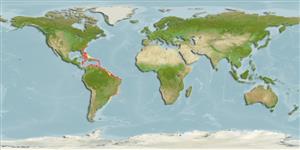Environment: milieu / climate zone / depth range / distribution range
Ecologie
marien rifbewoner; diepte 1 - 75 m. Subtropical; 37°N - 33°S, 82°W - 34°W
Western Atlantic: North Carolina, USA and Bermuda to Brazil.
Grootte / Gewicht / Leeftijd
Maturity: Lm ? range ? - ? cm
Max length : 56.0 cm TL mannelijk / geslacht onbekend; (Ref. 26340); common length : 30.0 cm TL mannelijk / geslacht onbekend; (Ref. 3815); max. gepubliceerd gewicht: 680.00 g (Ref. 40637)
The cheek area is usually blue with yellow spots; the blue markings on the scales are more linear; no horizontal blue band above the gill opening, but a dark bluish smudge may often seen behind the upper end of the opening (Ref. 13442).
Adults are frequently found in coral areas, while the young prefer vegetated (e.g. Thalassia), sandy bottoms. Feeds mainly on mollusks, worms, brittle stars, hermit crabs, crabs and sea urchins. Easily approached (Ref. 9710). Marketed fresh and frozen (Ref. 5217).
Levenscyclus en paargedrag
Maturiteit | Voortplanting | Paaien | Eieren | Fecunditeit | Larven
Robins, C.R. and G.C. Ray, 1986. A field guide to Atlantic coast fishes of North America. Houghton Mifflin Company, Boston, U.S.A. 354 p. (Ref. 7251)
Status op de Rode Lijst van het IUCN (Ref. 130435)
Gevaar voor de mens
Reports of ciguatera poisoning (Ref. 30911)
Gebruik door de mens
Visserij: van minder commercieel belang
Meer informatie
Lokale namenSynoniemenMetabolismePredatorenEcotoxicologieVoortplantingMaturiteitPaaienPaaiaggregatiesFecunditeitEierenOntwikkeling van de eieren
Tools
Speciale rapporten
Download XML
Internetbronnen
Estimates based on models
Preferred temperature (Ref.
123201): 22.8 - 27.9, mean 26.7 °C (based on 222 cells).
Fylogenetische diversiteitsindex (Ref.
82804): PD
50 = 0.5001 [Uniqueness, from 0.5 = low to 2.0 = high].
Bayesian length-weight: a=0.02291 (0.01433 - 0.03663), b=2.93 (2.80 - 3.06), in cm total length, based on LWR estimates for this species & Genus-body shape (Ref.
93245).
Trofisch niveau (Ref.
69278): 3.5 ±0.2 se; based on diet studies.
Weerstandsvermogen (Ref.
120179): laag, minimale populatieverdubbelingstijd 4,5-14 jaar (Preliminary K or Fecundity.).
Fishing Vulnerability (Ref.
59153): Moderate vulnerability (42 of 100).
Nutrients (Ref.
124155): Calcium = 22.6 [9.6, 46.7] mg/100g; Iron = 0.517 [0.263, 1.088] mg/100g; Protein = 20 [19, 21] %; Omega3 = 0.167 [0.095, 0.304] g/100g; Selenium = 17.5 [7.7, 36.4] μg/100g; VitaminA = 29 [7, 124] μg/100g; Zinc = 0.63 [0.39, 0.96] mg/100g (wet weight);
